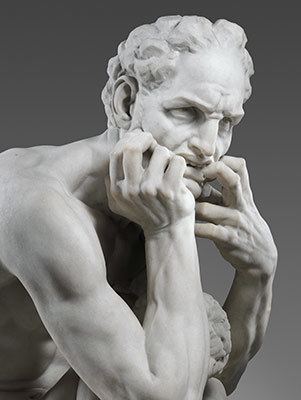Type sculpture | Medium plaster Year 1881 | |
 | ||
Dimensions 46.5 cm × 38.5 cm × 44.2 cm (18.3 in × 15.2 in × 17.4 in) Similar Auguste Rodin artwork, Other artwork | ||
Ugolino and his sons
Ugolino and his sons is a plaster sculpture by French artist Auguste Rodin, part of the sculptural group known as The Gates of Hell. As an independent piece, it was exhibited by its author in Brussels (1887), Edinburgh (1893), Genoa (1896), Florence (1897), Netherlands (1899) and in his own retrospection (1900).
Contents
- Ugolino and his sons
- The gates of hell movement 5 ugolino and his sons
- Theme
- Background and conception
- Ugolino in The Gates of Hell
- References
The gates of hell movement 5 ugolino and his sons
Theme
Ugolino della Gherardesca was an aristocrat and politician who lived in Pisa during the 13th century. After five years of government in his natal city, he was tried for betrayal and arrested along with his children and grandchildren. They were incarcerated at the Muda Tower, where they died of starvation nine months later.
Dante Alighieri wrote the story of Ugolino in his Divine Comedy, where the aristocrat is placed in the deepest circle of Hell. He is the one who explains Dante how the prisoners were slowly dying and his own sons begged him to eat them after their deaths. This story is the reason why Ugolino is known as "The Cannibal Count" and is often represented as eating his own fingers.
Background and conception
Jean-Baptiste Carpeaux— French sculptor of the 19-th Century— started a project about Ugolino and his sons for the French Academy of Fine Arts. This was an independent piece to be delivered to the French Government after winning a scholarship for travelling to Rome to study at Villa Medici. For several years, he worked on a sculpture that transmitted agony, fury and desperation. the main character has one hand on his chin and his fingers in the mouth. This is Rodin's main source of inspiration for his own Ugolino and his sons and The Thinker as well, since they have the same posture.
Ugolino in The Gates of Hell
Ugolino's episode in the Divine Comedy had a great impacto on Rodin. In the early models of The Gates of Hell, Ugolino's representation is already an important theme, one of the first two episodes from Dante's poem to be interpreted as sculptures. The first studies show how Rodin's first intention was to show the Count in a vertical position like Carpeaux. In his final version, however, Ugolino is shown in a horizontal position, perhaps to reinforce the inhumanity of his action. He's found on his knees, leaning to the front with a desperate gesture and an open mouth. Rodin made hsi piece distinct from Carpeaux's and so achieved a unique artwork with strong dramatic tones. The sculpture was enlarged by Henri Lebossé between 1901 and 1904. This version presents several differences with the small model. Even though the French government asked for a bronze cast, this was only done after the artist's death and is found today (2016) at the gardens of Musée Rodin at the south side of the Hôtel Biron.
In The Gates of Hell, Ugolino's group is found on the lower half of the left door in such a way that it's not possible to observe the fourth child next to Ugolino's right leg. This is considered one of several examples of The Gates not having a single, unique perspective to be admired from.
